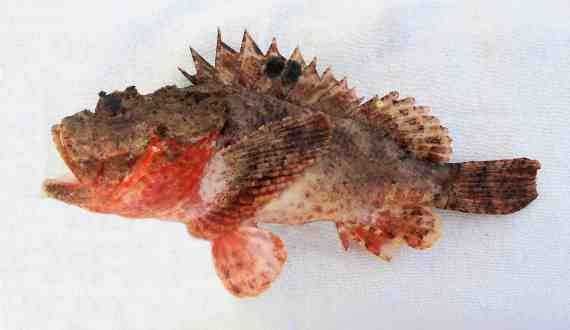Pacific Spotted Scorpionfish

Species Details
Scorpaena Mystes
Scorpaenidae
Scorpaeniformes
Rocky Reefs, Wrecks, Coral Reefs, Caves, Crevices
2 - 4 lbs.
8" - 20"
Pacific Spotted Scorpionfish (Scorpaena Mystes) Description
The Pacific Spotted Scorpionfish is a brown colored fish covered in an array of spines. Its skin seems to be quite rough, allowing it to blend with the rocky reefs and continental shelves. Their dorsal portion is dark brown but their bellies are white. The Pacific Spotted Scorpionfish has a bright red chin and bright red spots that decorate its pectoral fins. One of the best ways to identify a Pacific Spotted Scorpionfish is by the dots on its pectoral fins. It has a cluster of white dots on the black portion of its fin, distinguishing the Pacific Spotted Scorpionfish from other species.
The Pacific Spotted Scorpionfish is also known for the four black-spotted, orange dorsal fins. Its caudal fin appears like a fan, with rounded edges. Another thing to note is that its tail has long stripes that run across the tailfin. Pacific Spotted Scorpionfishes come in all sorts of colors from dark red, brown, and bright orange.
Diet and Size
Pacific Spotted Scorpionfish don’t have teeth in their mouth. Rather, they inhale their food. Pacific Spotted Scorpionfish have cavernous mouths and teeth that line their throat. They use the teeth in their throat to grind up bony fishes, squid, and octopi. They also sometimes eat crabs.
The common length of a Pacific Spotted Scorpionfish is around 12 inches (30.4 cm). The smallest adult Pacific Spotted Scorpionfish measured around 8 inches. But the maximum length of one was around 20 inches.
Interesting Facts about the Pacific Spotted Scorpionfish
- Pacific Spotted Scorpionfish are classified as traumatogenic.
- According to some studies, Pacific Spotted Scorpionfish may be traumatogenic due to their appearance and venom.
- Pacific Spotted Scorpionfish are known to have white and tasty meat.
- Fear of fishing for it may be due to the barbs that the fish has.
- The presence of their venomous spines makes them the most poisonous fish in the ocean.
- When stung, people will suffer burning pain and swelling at the site where they were stung. The poison is also very potent, quickly spreading to other parts of the body.
- If poisoned by a Pacific Spotted Scorpionfish, immediately remove the person from water to prevent them from drowning.
- Then, place the site of the sting in hot water. As hot as the victim can stand.
- Do not cover the wound. Use tweezers to extract any spines.
- The Pacific Spotted Scorpionfish can live up to 15 years.
- A female Pacific Spotted Scorpionfish can lay up to 15000 eggs. When fertilized, the eggs float to the surface to prevent predators from getting to them.
Fishing Techniques: How to catch a Pacific Spotted Scorpionfish
Whether it’s for the thrill or if anglers are just plain bored, catching a Pacific Spotted Scorpionfish is a meticulous process. These fish normally feed at night so low visibility for you which also means be extra careful. Some people have already reported being stung by a Pacific Spotted Scorpionfish multiple times because they didn’t know where it was.
Pacific Spotted Scorpionfish are carnivorous but usually prefer their feast of crustaceans such as shrimp and crab. Having some squid and octopi help also. But some anglers took note that they’re not completely picky with food. One even managed to use a live Queenfish and still managed to catch one. They also feed on anchovies and mackerel. For the size of the hook, people recommend using a size 4.
Normally, Pacific Spotted Scorpionfish do not attack back. They usually just shoot out their spines and run away. However, if you manage to corner it, be careful. If the Pacific Spotted Scorpionfish feels cornered, it will charge at you at full speed with barbs and all.
Once you’ve caught it, do not use your bare hands to handle it. Use a pair of leather gloves or a pair of large tongs to put it in a sack or basket. If in a sack, better to put it in at least four plastic bags to prevent the spines from puncturing you and sending you to the hospital.
Habitat and Distribution
Pacific Spotted Scorpionfish love digging underneath the sand. They have a preference for rocky areas. Rocky reefs, wrecks, and sometimes even sewer pipes might be their preferred habitat! Most of the time, they can be found in caves and crevices where they can hide in peace. They’re ambush-type fish which means they’ll have a tendency to hide more in the little crevices than be out in the open.
During the day, they usually go around in a pair or alone. They’re not as active as they are at night, however. Be careful also when treading through the water during the day. Sometimes, you might find yourself stepping on something with spines.







